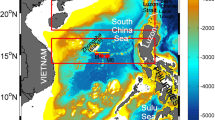Abstract
Upper-layer circulation in the South China Sea has been investigated using a three-dimensional primitive equation eddy-resolving model. The model domain covers the region from 99° to 122°E and from 3° to 23°N. The model is forced by the monthly averaged European Centre for Medium-Range Weather Forecasts (ECMWF) model winds and the climatological monthly sea surface temperature data from National Oceanographic Data Center (NODC). Inflow and outflow through the Taiwan Strait and the Sunda shelf are prescribed monthly from the Wyrtki estimates. Inflow of the Kuroshio branch current in the Luzon Strait is assumed to have a constant volume transport of 12 Sv (1 Sv = 106 m3/s), and the outflow from the open boundary to the east of Taiwan is adjusted to ensure the net volume transport through all open boundaries is zero at any instant. The model reveals that a cyclonic circulation exists all year round in the northern South China Sea. During the winter time this cyclonic eddy is located off the northwest of Luzon, coinciding with the region of positive wind stress curl in this season. This cyclonic eddy moves northward in spring due to the weakening of the northeast winds. The cyclonic circulation becomes weak and stays in the continental slope region in the northern South China Sea in the summer period. The southwest wind can raise the water level along the west coast of Luzon, but there is no anticyclonic circulation in the northern South China Sea. After the onset of the northeast monsoon winds in fall, the cyclonic eddy moves back to the region off the west coast of Luzon. In the southern South China Sea and off the Vietnam coast, the model predicts a similar flow structure as in the previous related studies.
Similar content being viewed by others
References
Chao, S. Y. and T. Paluszkiewicz (1991): The hydraulics of density currents over estuarine sills. J. Geophys. Res., 96, 7065-7076.
Chern, C. S. and J. Wang (1998): A numerical study of the summertime flow around the Luzon Strait. J. Oceanogr., 54, 53-64.
Hellerman, S. and M. Rosenstein (1983): Normal monthly wind stress over the world ocean with error estimates. J. Phys. Oceanogr., 13, 1093-1104.
Holland, W. R. (1978): The role of mesoscale eddies in the general circulation of the ocean-numerical experiments using a wind-driven quasi-geostrophic model. J. Phys. Oceanogr., 8, 363-392.
Hu, J., H. Kawamura, H. Hong and Y. Qi (2000): A review on the currents in the South China Sea: seasonal circulation, South China Sea warm current and Kuroshio intrusion. J. Oceanogr., 56, 607-624.
Ko, M. J. (2001): Current around Taiwan. Master Thesis, Institute of Oceanography, National Taiwan University, Taipei, Taiwan (in Chinese).
Levitus, S. (1982): Climatological atlas of the world oceans. NOAA Prof. Paper No. 13, U.S. Government Printing Office, 173 pp.
Nitani, H. (1972): Beginning of the Kuroshio. p. 129-163. In Kuroshio, ed. by H. Stommel and K. Yoshida, University of Washington Press, Seattle.
Qu, T. (2000): Upper-layer circulation in the South China Sea. J. Phys. Oceanogr., 30, 1450-1460.
Semtner, A. J. and Y. Mintz (1977): Numerical simulation of the Gulf Stream and mid-ocean eddies. J. Phys. Oceanogr., 7, 208-230.
Shaw, P. T. and S. Y. Chao (1994): Surface circulation in the South China Sea. Deep-Sea Res., 41, 1663-1683.
Takano, K., A. Harashima and T. Namba (1997): A numerical simulation of the circulation in the South China Sea-Preliminary results. Acta Oceanogr. Taiwanica, 37, 165-186.
Wang, J. and C. S. Chern (1996): Some aspects on the circulation in the northern South China Sea. La mer, 34, No. 3, 246-257.
Wang, J. and C. S. Chern (2000): Some observations on the Kuroshio intrusion process in the Luzon strait in the northern South China Sea. Acta Oceanogr. Taiwanica, 38, 129-151 (in Chinese with English abstract).
WOA98/NODC (1998): World ocean atlas 1998, CD-ROM data set. Ocean Climate Laboratory, National Oceanographic Data Center, U.S.A.
Wu, C. R., P. T. Shaw and S. Y. Chao (1999): Assimilating altimeter data into a South China Sea model. J. Geophys. Res., 104, C12, 29987-30005.
Wyrtki, K. (1961): Physical oceanography of the Southeast Asian water. Naga Report, 2, 195 pp.
Author information
Authors and Affiliations
Rights and permissions
About this article
Cite this article
Chern, CS., Wang, J. Numerical Study of the Upper-Layer Circulation in the South China Sea. Journal of Oceanography 59, 11–24 (2003). https://doi.org/10.1023/A:1022899920215
Issue Date:
DOI: https://doi.org/10.1023/A:1022899920215



